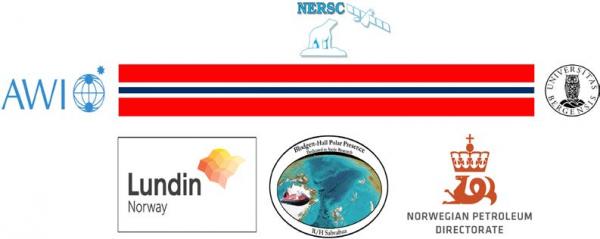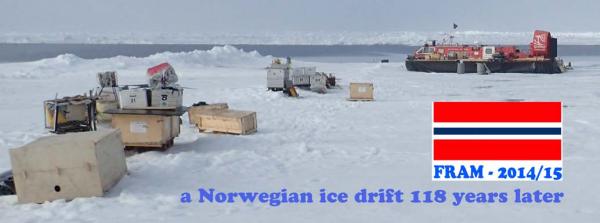
(22- 28 June 2015)
Ice drift
The ice camp drifted 22 nautical miles (41 km) during week forty-three, but effectively only 12 nautical miles in the"right" direction along the coast (Fig. 1). Water depths are 2600-3100 meters. The surface air pressure was a high extending from Greenland to Novaja Zemlja at the beginning of the week and gradually turning east to the Laptev Sea area towards the weekend. Local winds were variable through Tuesday and from the southeast on Wednesday and Thursday which drove the ice away from the coast (Fig. 1). From Friday on, we had winds from the north and the ice drifted south.
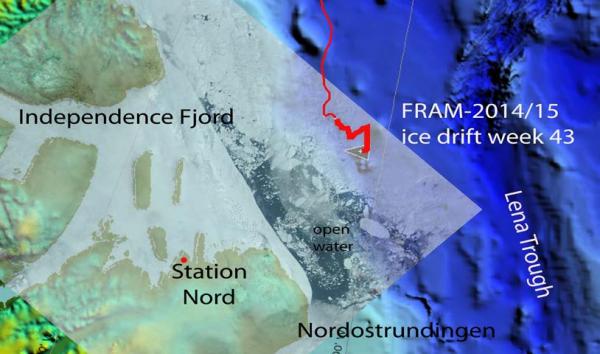
Fig. 1. The drift of FRAM-2014/15 during week 43, 22- 28 June 2015 ( thick red line). The satellite image (http://ocean.dmi.dk/arctic/images/MODIS/Nord/20150629AQUA.jpg) courtesy of Danish Meteorological Institute shows the ice distribution and is draped over the bathymetry from the International Bathymetric Chart of the Arctic Ocean (IBCAO).
Sea ice dynamics
The crack behind the hovercraft widened to about 200 meter last week and started to come together again. The first thing in the early hours on Monday was to move the hovercraft about 30 meter into the floe and park for the night. Later, we moved over to the floe where all the equipment was and parked a similar distance from the lead. At the end of the week, the lead widened to a maximum of about 500 meter. The ice is generally slack and no pressuring occurs.
The sea ice cover in our area has a free boundary to the south and also to the west since open water is present most of the time between our location and the coast of Northeast Greenland. The general sea ice movement is divergent dominated by cracking and lead formation . Pressure ridges are rarely formed as individual floes have limited momentum. From our perspective, divergent motion is the least problematic form of sea ice dynamics. Ice pressure during the winter has transformed the sea ice surface in our vicinity to a dense network of ridges and we actually welcome extensive break-up of the ice and formation of leads in order to get out. We have stated several times in the past that formation of cracks are virtually harmless unless you by chance straddle the break. The hovercraft is like a lonely car in a vast parking lot and is moved as easy as any car. A platform of two meter thick sea ice is for all practical purposes a local "terra firma" considering loads represented by a small ice camp. The thickness of our floe is more than the requirement for landing a 200 ton cargo plane on the sea ice runway in Mc Murdo, Antarctica. A floe 100-150 meter in diameter will have the buoyancy to carry our camp one hundred times over and is considered by us as the ideal platform for a continued safe ride south. Unfortunately, the image of an ice crack or an isolated drifting ice floe may seem frightening to many people. If a situation arises, any action taken should be rooted in the reality at the site and not originate from some outsider's unconstrained and uninformed imagination. In this respect, the drift in 1893- 1896 clearly had an advantage.
Camp life
As always, days of complete overcast and low light contrast dominate throughout the week. Tuesday and Sunday was glorious. Temperatures have been between -2 °C and +2 °C. The vigorous snow melt generate fresh water which flood the low areas on the ice, saturate the snow and form melt ponds. The ponds absorb the sun light more efficiently than the snow and deepen - some may even extend through the ice at the end of the season. Pictures from past ice stations show extensive melt ponds within the camp areas and small boats were used to move around. We drill a hole in the ponds and the fresh water drains quickly into the ocean below (Fig. 2).
We have placed the cargo on pallets on higher ground to avoid melt water damage (Fig. 3)
The melt water can be used for drinking water (Fig. 4). Carefully chosen ponds have water with no perceptible taste of salt. From now on we do not need to have the generator running all day to melt snow for our water supply.
As the ice cover gradually disintegrates and wide leads form, the motion is no longer entirely coherent, but individual floes rotate during the drift. From Friday to Sunday, our floe rotated 18 degrees.
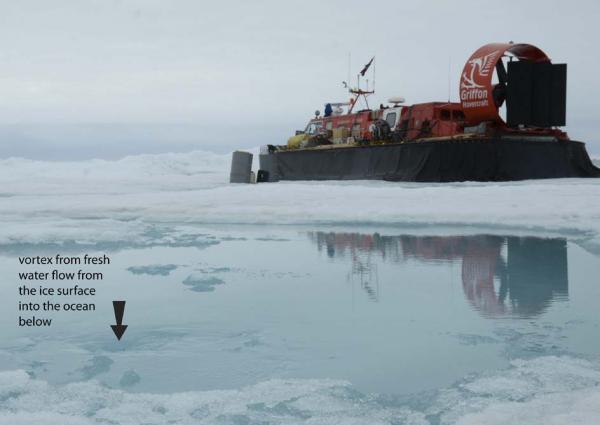
Fig. 2 Draining melt water ponds
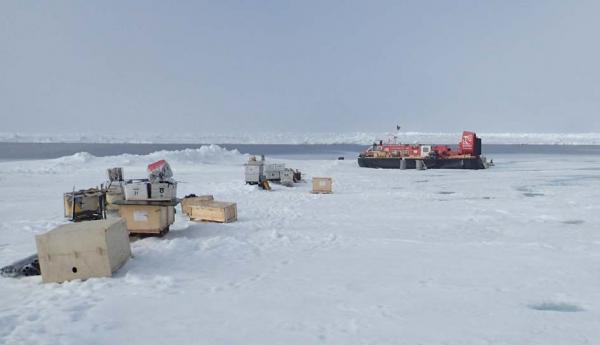
Fig. 3 The camp area as of 28 June.
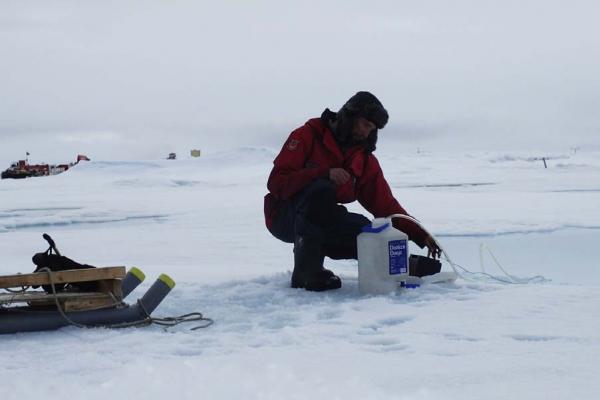
Fig. 4 Audun pumping fresh melt water from a melt pond.
Science
Underway continuous measurements:
Bathymetry:
- Syquest echo box and autonomous data acquisition reporting via Iridium to CMR, Bergen
Atmosphere:
- measurement of incoming and outgoing radiation from the ice surface
- surface infrared skin temperature
- sun time
- Aanderaa weather station
Station work
- 1 CTD casts to 1000 meter depth; one every 5 nautical mile
The water depth (c. 3000 m) is out of reach of our remaining Kevlar line (c. 2700 m) so no bottom sampling is possible.
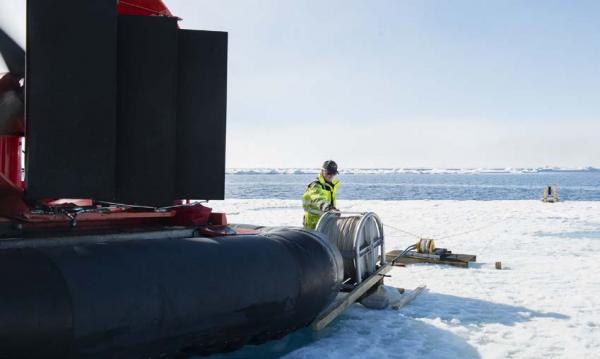
Fig. 5 Making a CTD cast in the nearby lead
W e now make the CTD casts in the large lead 25 meter away from where the hovercraft is temporary parked (Fig. 5 ). Also, the transducer of the echo box is lowered into the lead. Smaller floes move freely within the large open water area driven by the tide and the wind and pile up in alternate ends. We sometimes recover the transducer in the evening to avoid damage from colliding floes while we are asleep.
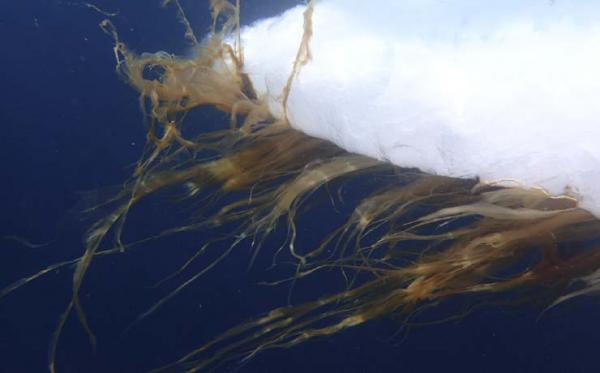
Fig. 6 Algal? growth on the underside of the ice
Interesting cases of algae? growth are observed below some ice floes (Fig. 6).
Wild life
During the week, we have had visits by the following new species:
Kitty wake, Ruddy turnstone, Sabine's gull, Brunnich guillemot, Little auk, Arctic tern and Iceland gull/Glacous gull. A hooded seal has also been observed.
A polar bear visited us on 23 June.
Life in the High Arctic treats us well.
Yngve Kristoffersen & Audun Tholfsen
Daily reports
Monday 22 June
Position: 82° 33.33' N, 11° 55.9' W, temperature +1 °C, air pressure 1021 hPa, wind 8 knots from the N. Ice drift 0.15 towards SE. The wide lead behind the hovercraft started closing in the early morning and the hovercraft was moved 30 into the floe and parked for the night. The weather station mast fell over as the pegs for the guide wires had melted out. Moved both the weather station and the radiation flux instrument mast to the floe where all our cargo is assembled, and aligned the sensors with the North-direction. Orientation of the sun-time sensor was corrected. Initiated data logging.
Tuesday 23 June
Position: 82° 32.36' N, 11° 39.5' W, temperature +1 °C, air pressure 1020 hPa, wind 4 knots from the NNW. Ice drift 0.15 knot towards SE. Mist in the morning, but later a glorious day. Visit by one or two polar bears during the night. The weather station mast was down, and the animal(s) had worked at the food storage, but done no significant damage. Moved more cargo to higher areas. Bathymetry buoy voltage 12.33 volt.
Wednesday 24 June
Position: 82° 29.92' N, 11° 26.4' W, temperature -2 °C, 1021 hPa, wind 11 knots from the SE. Ice drift 0.05 knot to the NE. Made one CTD cast. Had to move the radiation flux
instrument about 10 meter, because the polar bear(s) had left tracks within the area imaged by the radiation sensors.
Thursday 25 June
Position: 82° 32.1' N, 11° 15.7' W, temperature -2 °C, air pressure 1016 hPa, wind 15 knots from the SSE. Ice drift 0.2 knot towards NE. Moved cargo and organized some of the food. Melt water is accumulating on the ice. We drill holes to drain the fresh water and inhibit formation of melt ponds in our immediate vicinity.
Friday 26 June
Position: 82° 31.81' N, 10° 50.9' W, temperature 0 °C, pressure 1018 hPa, wind 9 knots from the NW. Ice drift 0.3 knot towards the SE. GPS measurement for determination of the North-direction and the azimuth of the hovercraft (163 degrees). The weather station and radiation flux instrument boom checked for N-S alignment.
Saturday 27 June
Position: 82° 29.49' N, 10° 47.5' W. Temperature +2 °C, air pressure 1021 hPa, wind 4 knot from the NW. Ice drift 0.1 knot towards the S. Overcast, low clouds, rain before noon. Work on a wooden crate for the compressor. Engine maintenance - checking for possible oil and cooling water leaks.
Sunday 28 June
Position: 82° 26.83' N, 10° 47.8' W, temperature 0 °C, air pressure 1024 hPa, wind 4 knots from the N. Ice drift 0.15 knot to the S. Continued engine maintenance and dismounted the compressor , air hoses and air bottles. The lead that opened behind the hovercraft and was closing at the beginning of the week is no at least 500 meter wide. For the first time we replenished our drinking water supply from the melt ponds. There is no detectable taste of salt. The azimuth of the hovercraft was 163 degrees on Friday and was now measured to 141 degrees.
